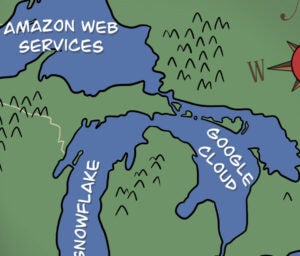“On TV & Video” is a column exploring opportunities and challenges in advanced TV and video.
Today’s column is by Tom Wolfe, SVP of business development at Viant.
Targeting. Attribution. ROAS. Digital Audio. CTV. Influencers. The marketing funnel is ever-changing, and cookie deprecation isn’t making things any easier. Advertisers have two choices: Collaborate with industry partners on the front edge of next-generation data solutions or cling to the past and hope for the best.
Marketers who select the latter have a security blanket: traditional, linear TV. Despite massive reports of cord-cutting and growing confusion in the measurement space, traditional linear TV still commands high budgets. According to eMarketer, 2022 upfront TV buying hit $19.21 billion. Connected TV (CTV) climbed 35% to $8.14 billion. Impressive growth, but only 42% of the linear TV total, against viewership that equals 48% of the linear TV total. While the future methodology of measuring non-digital linear TV is unclear, we have undoubtedly reached a tipping point.
Buyers continue to ask media outlets to prove the value of connected TV. They still want to understand the “incremental” reach. But here’s the rub: Most viewers don’t gather round for “Must See TV” anymore. They watch across all platforms, on their schedule. Today, the average adult falls asleep at 11:39 p.m. and spends much of primetime consuming content on a mobile device. Digital media consumption is nearly double that of traditional media consumption. Linear is becoming a relic of the past.
This seismic shift requires a thoughtful, data-driven, omnichannel approach to advertising strategy.
Letting go of linear
Today, linear providers struggle to engage new users with an outdated model, cannot operate programmatically and represent a sliver of total media consumption.
In a world where consumers enjoy content across digital omnichannel, linear – not connected TV – should be treated as incremental.
All TVs are now streaming-capable. MVPDs are offering streaming boxes. Virtual MVPDs offer linear services.
Sports will continue to be important to branding, and streaming services will soon escalate bidding to win the majority of events. Ads are even coming to HBO, Disney+ and Netflix. Walled gardens are here to stay, but they limit advertisers’ ability to reach their target audiences as effectively as a DSP expertly versed in data strategy, omnichannel targeting and performance and next-generation reporting capabilities.
As connected TV matures, viewers will continue to lean back. But CTV and digital video are more closely intertwined with other parts of the funnel, especially when compared to linear.
Buyers can access verified, privacy-compliant, cookieless household IDs built on multiple identifiers, couple them with deep omnichannel inventory partnerships and connect the dots – from awareness to purchase to loyalty.
Connected TV, together with other digital platforms, offers a deeper, richer engagement with consumers. It’s time to embrace connected TV’s starring role in omnichannel planning and activation.
Follow Viant (@viant_tech) and AdExchanger (@adexchanger) on Twitter.
For more articles featuring Tom Wolfe, click here.













